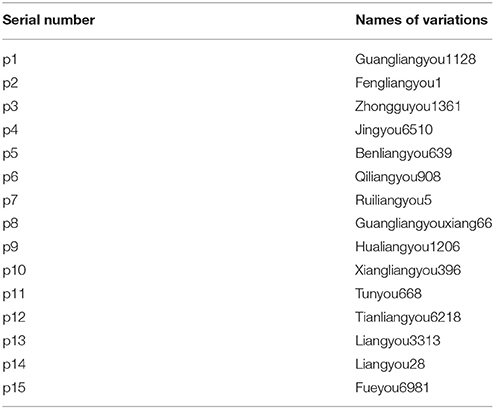- 1Agricultural College, Guangxi University, Nanning, China
- 2Institute of Agro-Environmental Protection, The Ministry of Agriculture, Chinese Academy of Agricultural Sciences (CAAS), Tianjin, China
- 3Innovation Team of Remediation of Heavy Metal Contaminated Farmland Soil, Chinese Academy of Agricultural Sciences, Tianjin, China
- 4College of Resources and Environment, Huazhong Agricultural University, Wuhan, China
- 5CNPC Greatwall Drilling Company, Liaohe, China
This study was conducted to understand why and how the technologies of variety screening, foliar dressing, and water management can reduce As/Cd accumulation and affect the concentrations of essential elements in different rice plants. In Trial I (variety screening), the grain As and Cd concentrations in Zhongguyou1361 variety (P3) were both lower than their individual National Food Hygiene Standard of China (NFHSC) under insufficient field drying condition. The P3 also had a relatively high yield and high essential element contents among 15 selected rice varieties. In Trial II (foliar dressing), selenite foliar spray showed a better ability than silicate to reduce the grain As content in Guangliangyou1128 variety (P1). However, spraying Se and Si onto the Fengliangyou1 variety (P2) both showed a limited effect on the grain As and Cd contents, suggesting a different effect of Se on grain As content in various rice varieties. The insufficient field drying in Trial II resulted in the grain Cd content being lower but the grain As content being higher than their individual NFHSC in both P1 and Fengliangyou1 (P2) varieties. Se or Si did not affect the yields and the grain contents of most essential elements in P1 and P2. In Trial III (water management), increasing field drying time enhanced the Cd content but reduced the As content in the grains of P1, P2, and P3, and maintained their yields. Similar to the results of Trial II, the changes in soil pH, organic matter concentration and elemental available concentrations could hardly be used to explain why the contents of corresponding essential elements kept approximately constant in the grains of different rice varieties. Foliar dressing with selenite combined with water regulation can simultaneously reduce the As and Cd contents, and maintain the yields and the essential element contents in the grains of rice plants cultivated in As− and Cd− contaminated soil.
Introduction
The rapid development of industry and agriculture in China has resulted in a worsening of the environment, and heavy metal and metalloid soil contamination is a particularly prominent issue (Cheng, 2003). In 2014, a countrywide survey of soil pollution status in China shows that the cadmium (Cd) concentration in 7.0% of total soil samples and the arsenic (As) concentration in 4.8% of total soil samples exceeds their individual Chinese environmental quality standard for soils.
Crops can accumulate considerable amounts of heavy metals (metalloids), which can not only seriously affect the growth and development of crops, but also threaten the health of animals and humans through the food chain (Liu et al., 2008; Zhai et al., 2008). Rice plant, the main grain crop in China, is prone to accumulate As and Cd in its grains (Sun et al., 2010). The co-accumulation of As and Cd in rice plants has emerged as a prominent issue in China and other Asian countries (Wang and Stuanes, 2003; Liu H. Y. et al., 2005; Williams et al., 2009). Therefore, it is crucial to explore some technologies to control their contents in the grains of rice plants.
Currently, researchers often use some remediation techniques to reduce heavy metal (metalloid) contents in rice plants, primarily via in-situ passivation, foliage dressing, and water regulation (Friesl et al., 2003; Guo et al., 2006; Zahedi et al., 2009; Hu et al., 2013; Zhou R. et al., 2017; Zhou Y. et al., 2017; Zhou Y. Y. et al., 2017). Sometimes in-situ passivation exhibits a noticeable remediation effect at the cost of a high cost and a damaged soil structure or fertility. Therefore, it is imperative to find a remediation technique characterizing with easy accessibility, economy, and environmental friend to reduce the contents of heavy metals (metalloids) in crops. Flooding is reported to effectively reduce Cd content in rice plants (Bingham et al., 1976; Arao et al., 2009), which involved in a reduced reaction of to S2− in soil driving by some physical, chemical, and microbiological factors; and the S2− will then react with Cd to form an insoluble compound thereby reduce the Cd availability in soil (Bingham et al., 1976). However, flooding also markedly increases the available As concentration in soil, thus resulting in an enhanced As uptake in rice plants (Xu et al., 2008; Arao et al., 2009). In contrast to the cultivation pattern of flooding, rainfed cultivation, or alternate wetting and drying can substantially reduce the As content in rice plants (Xu et al., 2008; Li et al., 2009). The results of our recent field trials also demonstrated that when the rice varieties Fengliangyou 4 and Fengliangyouxiang 1 were grown in soil contaminated with Cd and As, field drying increased the grain Cd content and yield; however, insufficient field drying resulted in the grain As content exceeding the NFHSC (Liao et al., 2016).
In addition, foliar fertilizers like silicon (Si) are found to be able to effectively control the Cd content in various parts of rice plants (Shi et al., 2005). Appropriate levels of selenium (Se) can also reduce the uptake of Cd, lead (Pb), mercury (Hg), and As in plants, affording them a extra ability to resist the toxicity of these elements (He et al., 2004; Ding et al., 2015). Our previous study has shown that the high grain As content in the grains of Fengliangyou 4 due to a insufficient field drying could be significantly lowered by the extra foliage dressing with Se (Liao et al., 2016). Above results suggest that it is feasible to simultaneously reduce the As and Cd contents in the grains via water management combined with foliar dressing. Moreover, foliage dressing with Se can improve the Se content in rice grains and increase the average daily Se intake among residents living in Se-deficient areas.
When reducing the contents of heavy metals (metalloids) in rice grains using the relevant techniques, attention must be given to the effect of the techniques on rice growth and grain quality. Such research has been relatively lacking thus far. Moreover, the results of field trials are subjected to the constraints of climate and rice variety, requiring the data to be verified by successive trials at the same sites. On Here we hypothesize that these technologies can efficiently control the Cd and As accumulation and maintain the contents of essential elements in the grains of rice plants regardless of the changes in climate and rice variety.
Therefore, on the basis of our recent field trials, we conducted a continual study on variety screening, foliage dressing, and water regulation techniques to: (1) screen out some variety resources of rice plants which can accumulate low levels of Cd and As in their grains; (2) assess the efficiency of these technologies in reducing Cd and As accumulation and maintaining the yield and quality of rice grains.
Materials and Methods
Field Trial Site
This field study was carried out in 2015 and the field trial site was described in detail by Liao et al. (2016). The site was divided into three fields: the soil in the field used for the variety screening trial had a pH of 7.46, a Cd concentration of 3.39 mg kg−1, and an As concentration of 47.63 mg kg−1; the soil in the field used for the water management trial had a pH of 6.27, a Cd concentration of 2.74 mg kg−1, and an As concentration of 41.96 mg kg−1; and the soil in the field used for the foliage dressing trial had a pH of 6.87, a Cd concentration of 1.58 mg kg−1, and an As concentration of 54.10 mg kg−1. According to the secondary standards in the Chinese Soil Environmental Quality Standards (GB15618-1995), soil Cd concentrations in the three fields exceeded the quality standards by 456, 356.67, and 163.33%, respectively; soil As concentrations in the three fields exceeded the quality standards by 90.52, 67.84, and 116.4, respectively. The soil in all three fields represents typical Chinese farmland soil with combined heavy metal contamination.
Trial Design and Management Procedure
Trial I: Variety Screening
Fifteen rice varieties were selected for the variety screening trial. The variety names are listed in Table 1. Liao et al. (2016) provided detailed information onplot design, basal fertilizer application, and field management procedures. The variety screening trial was performed in 15 plots (7 × 5 m each). A 30-cm-wide space was left between adjacent varieties to aid in differentiating amongeach variety during planting. When seedlings were transplanted, each plot was basal-dressed with 1 kg of compound fertilizer (51% N26P10K15, Fuguan Manufacture City, China). In mid-June, each plot was top-dressed with 0.75 kg of special fertilizer (Zhongli Bioengineering Co. Ltd., Chongqing, China; containing 10% mefenacet and 0.01% bensulfuron-methyl). In early July, each plot was top-dressed with 0.45 kg of compound fertilizer (N26P10K15). The field was dried for 5 days from late tillering to the panicle initiation stage. Foliar compound fertilizer, “Penshibao” (Guangxi Beihai Penshibao Co. Ltd., Beihai, China), was sprayed in combination with pest control on the field at the end of July to early August.
Trial II: Foliage Dressing
Two rice varieties, P1 and P2, were selected for the foliage dressing trial. Foliage dressing was conducted in five treatments: no foliage dressing (CK); foliage dressing with 5 mg L−1 Se (Se1); foliage dressing with 8 mg L−1 Se (Se2); foliage dressing with 0.568 g L−1 Si (Si1); and foliage dressing with 1.42 g L−1 Si (Si2). Each treatment was performed in three replicates, with 30 plots in total using a randomized block design. Foliar fertilizer was sprayed twice (10 L solution per time), once each at the tillering and grain-filling stages. The foliar fertilizer consisted of analytical grade Na2SiO3•9H2O and Na2SeO3. Soil fertilization and other practices followed the same procedure as described in section Trial I: Variety Screening.
Trial III: Water Management
Three rice varieties, P1, P2, and P3, were selected for the water management trial. Water management was performed in three treatments: flooding throughout the rice growth period (treatment 1); field drying for 5 days from late tillering to the panicle initiation stage(treatment 2); and field drying for 10 days from late tillering to the panicle initiation stage(treatment 3). Each treatment was performed in three replicates, and the trial was conducted using a randomized block design, with 27 plots in total. Soil fertilization and other practices followed the same procedure as described in section Trial I: Variety Screening.
Sample Collection and Analysis
Collection and Processing of Soil and Plant Samples
Five plants (the entire plant with roots and soil) were collected from each plot using the quincunx sampling method. The plants were separated into two parts: shoots and roots. The shoots were placed in a mesh bag; after being washed, the panicles were separated and air-dried for yield measurement. The roots were placed in a different mesh bag after most of the soil adhering to the roots was removed. The roots were air-dried, and the attached soil was brushed off and collected as rhizosphere soil. In trials II and III, a portion of the rhizosphere soil was taken to analyze the pH (water: soil ratio = 5:1), organic matter content, and contents of available As, Cd, and essential elements. Air-dried panicles were threshed, and the obtained brown rice was pulverized using a small pulverizer, followed by digestion. The rhizosphere soil was passed through a 100-mesh sieve and, together with the rice grain samples, analyzed for Cd, As, Se, and essential elements. The digestion of soil and plant samples was performed as described by Liao et al. (2016).
Extraction of Available Elements From Rhizosphere Soil
Soil samples (5 g) were weighed into plastic bottles, and 25 mL of 0.1 mol L−1 HCl extraction solution was added to each sample. The soil suspensions were shaken in an oscillator (25°C, 180 r/min) for 2 h and then filtered. The filtrates were collected and stored until analysis. Inductively coupled plasma–mass spectrometry (iCAP Qc ICP–MS, Thermo Fisher, San Jose, CA, USA) was used to determine the available element concentrations in the rhizosphere soil and the element contents in the digested soil and plant samples (Ibaraki et al., 2010).
Determination of Organic Matter Content in Rhizosphere Soil
Soil samples (0.1 g) were weighed into dry test tubes, and to each tube, 5 mL of 0.8 mol L−1 1/6 K2Cr2O7 standard solution was added, followed by 5 mL of concentrated H2SO4. After the soil suspensions were thoroughly mixed, the tubes were placed in a phosphoric acid bath. Once the solution began to bubble in the tubes, time was recorded for 5 min of boiling. After cooling, the samples were transferred into Erlenmeyer flasks with ultrapure water and titrated with 0.2 mol L−1 ferrous sulfate; Phenanthroline was used as an indicator. The color changed from orange-yellow to blue-green and then to brick red, which was taken as the endpoint of the titration (GB 9834-1988).
Statistical Analysis
Each treatment was performed in three replicates. Data were analyzed using a one-way analysis of variance with Tukey's multiple comparison (P ≤ 0.05). Statistical analysis was performed using SPSS17.0 software (SPSS Inc., Chicago, IL, USA). Plots were generated using Sigmaplot (SPSS Inc., Chicago, IL, USA).
Results
Variety Screening Trial: Grain Yields and Element Contents
In trial I, 15 rice varieties were selected (Table 1). As shown in Figure 1, the Cd content was relatively low in the grains of the 15 rice varieties, none of which exceeded the NFHSC (0.2 mg kg−1). Nevertheless, the As content was relatively high in the rice grains, except for P3 and P8, which were below the NFHSC. The contents of Mg, K, and Ca in the grains of P1 were the highest, and the grain Mn, Fe, Cu, Zn, and contents and grain yield for P1 were also at a high level compared with the other 14 rice varieties (Table 2). Among the 15 varieties, P4 had the lowest grain yield, with relatively low levels of Mg, K, Cu, and Zn. P6 had the highest grain yield, and the contents of essential elements (except for Zn) were below the respective average levels. P3 had an above average grain yield and Ca, Mn, Cu, and Zn contents, whereas its Mg, K, and Fe contents were close to the respective average levels. P8 was lower than P3 in terms of its grain yield and Mg, K, Ca, Mn, Cu, and Zn contents; however, the Fe content was higher in grains of P8 compared with those of P3.
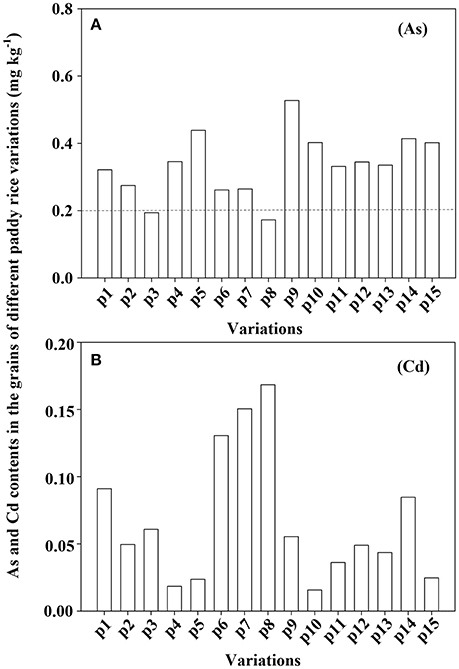
Figure 1. (A,B) The contents of As and Cd in the grains of 15 rice varieties in Trial I. The abbreviations of P1 to P15 denote the names of 15 rice varieties already illustrated in Table 1. Dotted line in (A) refers to the national standard of As in rice grains.
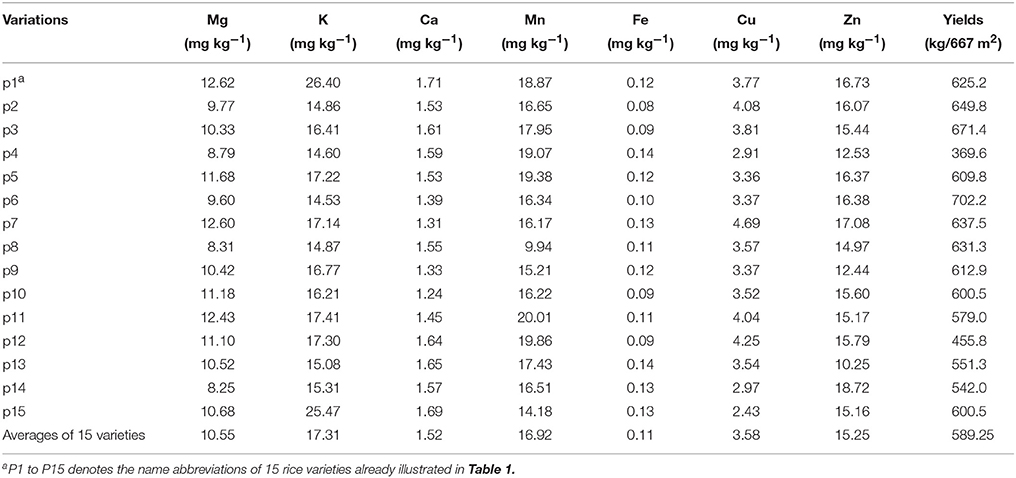
Table 2. The yields and the contents of some essential elements in the grains of 15 rice varieties in Trial I.
Foliage Dressing Trial
Rhizosphere Soil pH, Organic Matter Content, and Available Element Concentrations
Foliage dressing did not significantly affect the organic matter content in the rhizosphere soil of P1 or P2, except that the value of P2 in the control (CK) treatment was significantly higher than the other treatments (Table 3). The Se and Si treatments significantly increased the rhizosphere soil pH of P1 compared with CK, except that it was not significantly affected by the Si2 treatment. Unlike the results of P1, the Si2 treatment significantly increased the rhizosphere soil pH of P2, whereas the remaining Se and Si treatments showed no significant effect on it when compared with CK (Table 3).
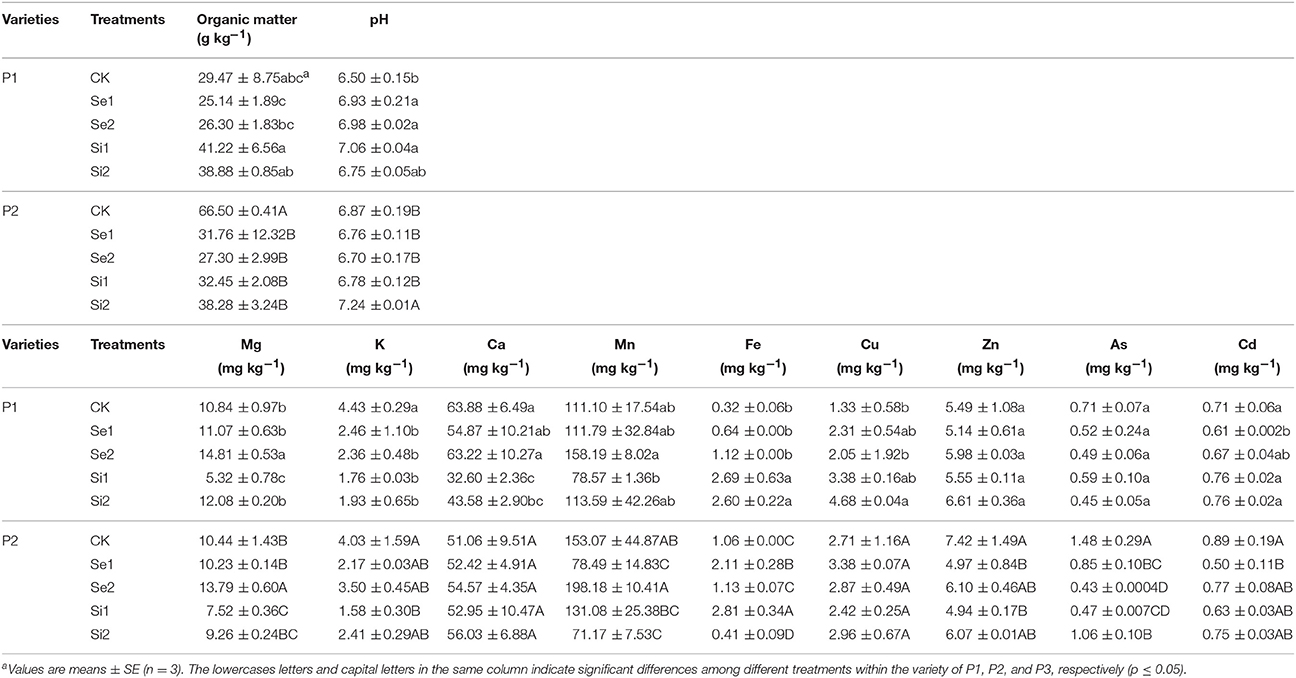
Table 3. The pH, organic matter concentrations, and available concentrations of As, Cd, and some essential elements in the rhizosphere soil in Trial II.
When compared with the CK, the Se2 treatment significantly increased the available Mg concentration of rhizosphere soil of P1, and reduced the available K concentration, but had no significant effect on the available concentrations of Ca, Mn, Fe, Cu, Zn, and As. The Se1 treatment remarkably reduced the available Cd concentration of rhizosphere soil of P1, but Se2 treatment showed no significant effect on it when compared with the CK (Table 3). Compared to the CK treatment, the Si2 treatment noticeably reduced the available K and Ca concentrations in the rhizosphere soil of P1, and significantly enhanced the available Fe and Cu concentrations, but showed no significant effect on the available concentrations of other tested elements. The Si1 treatment significantly reduced the available Mg concentration in the rhizosphere soil of P1 as compared with the CK treatment, but Si2 treatment showed no significant effect on it (Table 3).
In terms of P2, when compared with the CK treatment, the Se2 treatment obviously increased the rhizosphere soil available Mg concentration, and reduced the available As concentration, but had no significant effect on the available concentrations of other elements. The Se1 treatment significantly reduced the available Mn, Zn, and Cd concentrations, but increased the available Fe concentration compared to the CK treatment. The Si2 treatment significantly reduced the available Mn, Fe, and As concentrations; however, the Si1 treatment significantly reduced the available Mg, K, Zn, and As concentrations but increased the available Fe concentration.
Grain Yield and Element Contents
All the treatments containing Se or Si did not significantly affect the grain As content in both P1 and P2, except for the Se2 treatment where it significantly decreased the As content in the grains of P1 (Figure 2A) to be still higher than the NFHSC. The Cd content in the grains of P1 and P2 in all the treatments was lower than the NFHSC. However, it is worth mentioning that the Se1 treatment significantly enhanced the grain Cd content in P2 when compared with the CK, which was still lower than the NFHSC (Figure 2B).
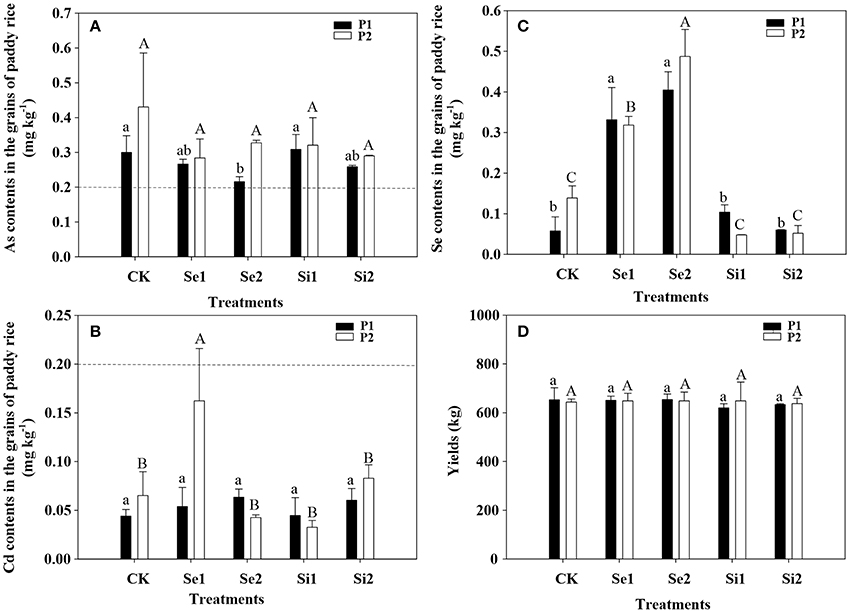
Figure 2. The yields (D) and contents of As (A), Cd (B), and Se (C) in the grains of P1 and P2 in Trial II. The abbreviations of P1 and P2 denote the names of two rice varieties already illustrated in Table 1. Bars are means and standard error for the mean of three replications. Different letters above bars indicate significant difference at P ≤ 0.05 between treatments (lowercase letters and capital letters denote significant difference between different treatments for P1 and P2 variety, respectively). Se1 and Se2 indicate foliage dressing with 5 and 8 mg Se L−1, and Si1 and Si2 indicate foliage dressing with 0.568 and 1.42 g Si L−1. CK indicates no foliage dressing. Dotted line in (A,B) refers to the national standard of As and Cd in rice grains.
The Se contents in the grains of P1 and P2 were significantly increased with increasing Se treatment concentrations (Figure 2C). The Se content in the grains of P1 fell into the range of 0.06–0.40 mg kg−1, but that in the grains of P2 was within the range of 0.14–0.49 mg kg−1 (data not shown). As compared with the CK treatment, the grain yields of P1 and P2 were not significantly affected by the foliar spraying of Se and Si (Figure 2D).
In P1 variety, the treatments containing Se and Si showed a non-significant effect on the contents of all tested elements in the grains, except for the Si2 treatment where the grain Fe content was significantly reduced (Table 4). In terms of P2 variety, when compared with the CK treatment the foliar sprayings of Se and Si remarkably reduced the grain Ca content, and the Si1 treatment significantly enhanced the grain Fe content, but other treatments showed a non-significant effect on the grain contents of Mg, K, Mn, Fe, Cu, and Zn (Table 4).
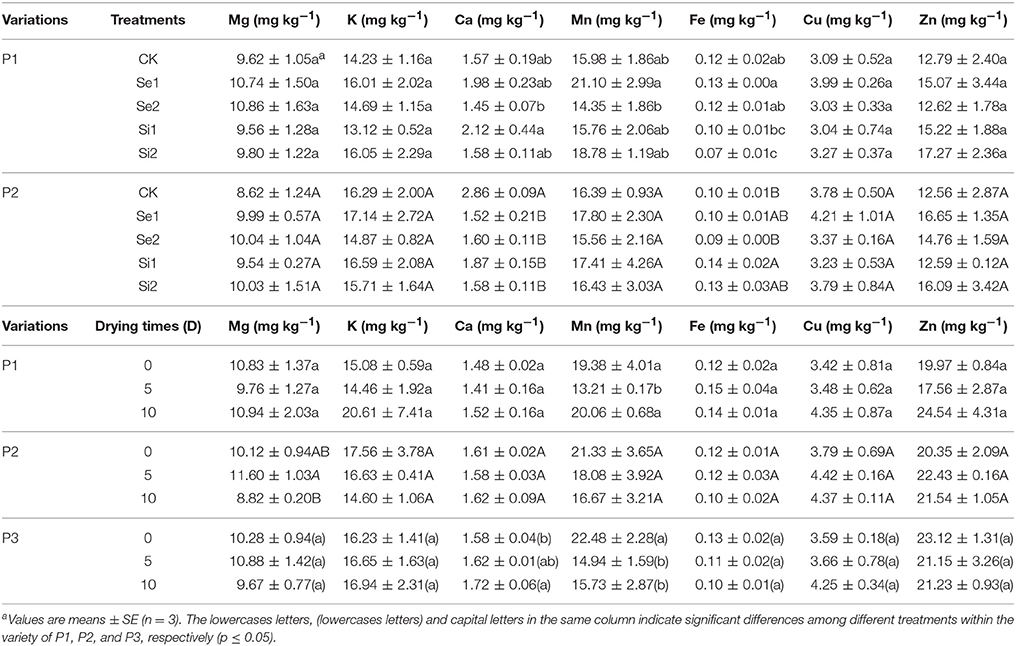
Table 4. The contents of some essential elements in the grains of rice plants in Trial II and Trial III.
Water Management Trial
Rhizosphere Soil pH, Organic Matter Content, and Available Element Concentrations
When compared with the flooding treatment, the field drying treatment showed a non-significant inhibitory effect on the rhizosphere soil pH value of all of the varieties of rice plants (Table 5). The effects of field drying treatments on the concentrations of rhizosphere soil organic matters differed largely with rice varieties. When compared to the flooding treatment, the field drying treatments showed a limited effect on the concentration of soil organic matters of P1 variety, but the treatment of field drying for 5 days significantly enhanced the concentrations of soil organic matters of P2 and P3 varieties. Interestingly, the treatment of field drying for 10 days showed a non-significant effect on the soil organic matter content of P2 variety when compare with the flooding treatment, however significantly reduced the soil organic matter content of P3 variety.
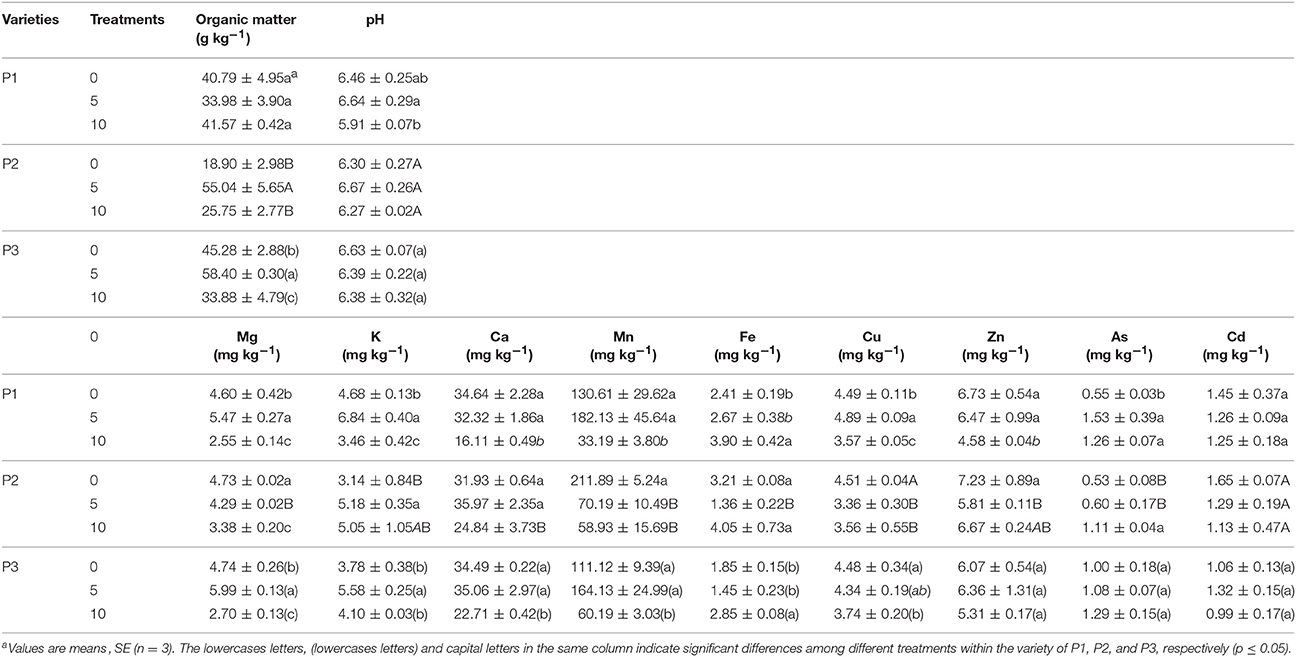
Table 5. The pH and organic matter concentrations and the available concentrations of As, Cd, and some essential elements in the rhizosphere soil in Trial III.
Concerning the P1 variety, when compared with the flooding treatment, the treatment of field drying for 5 days significantly enhanced the concentrations of available Mg, K, Cu, and As in the rhizosphere soil, but showed a limited effect on the available Ca, Mn, Fe, Zn, and Cd concentrations. The treatment of field drying for 10 days significantly reduced the available Mg, K, Ca, Mn, Cu, and Zn concentrations, but significantly enhanced the available Fe and As concentration when compared with the flooding treatment. The field drying seemed to show a non-significantly negative effect on the available Cd concentration (Table 5).
When compared with the flooding treatment, the treatment of field drying for 5 days significantly reduced the available Mg, Mn, Fe, Cu, and Zn concentrations, and increased the available K concentration, but non-significantly affected the available Ca and As concentrations in the rhizosphere soil of P2 variety. When compared with the flooding treatment, the treatment of field drying for 10 days significantly reduced the available Mg, Ca, Mn and Cu concentrations, and increased the available As concentration; but non-significantly affected the available K, Fe, and Zn concentrations in the rhizosphere soil of P2 variety. The field drying treatments seemed to show a non-significantly negative effect on the soil available Cd concentration (Table 5).
When compared to the flooding treatment, the treatment of field drying for 5 days significantly increased the available Mg and K concentration, and non-significantly affected the available Ca, Mn, Fe, Cu, Zn, As, and Cd concentrations in the rhizosphere soil of P3 variety. When compared with the flooding treatment, the treatment of field drying for 10 days significantly reduced the available Mg, Ca, Mn, and Cu concentrations, and increased the available Fe concentration, but showed a non-significant effect on the available K, Zn, As, and Cd concentrations in the rhizosphere soil of P3 variety (Table 5).
Grain Yield and Element Contents
As shown in Figure 3A, when compared with the flooding treatment, the treatment of field drying for 5 days significantly reduced the As content in the grains of P1 and P3 varieties to be lower than the NFHSC, but non-significantly reduced the As content in the grains of P2 variety. However, when compared to the flooding treatment, the treatment of field drying for 10 days significantly reduced the As content in the grains of all three rice varieties to be lower than the NFHSC.
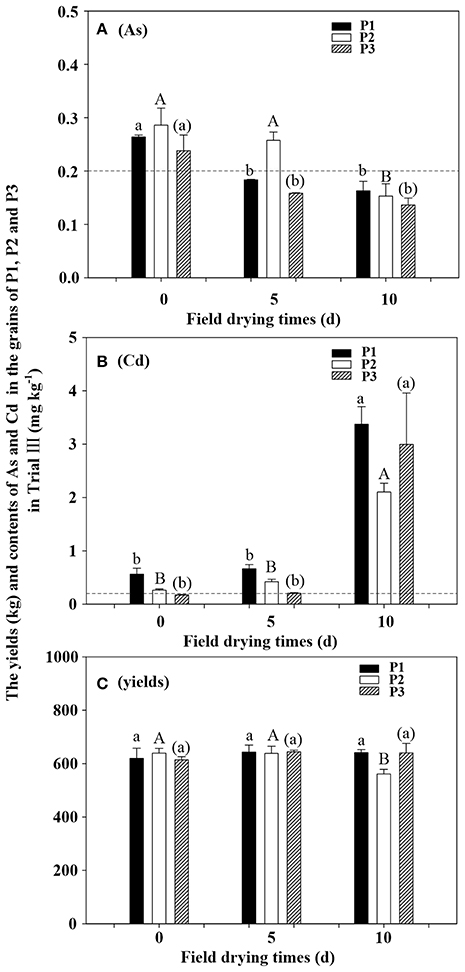
Figure 3. The yields (C) and contents of As (A) and Cd (B) in the grains of P1, P2, and P3 in Trial III. The abbreviations of P1, P2, and P3 denote the names of three rice varieties already illustrated in Table 1. Bars are means and standard error for the mean of three replications. Different letters above bars indicate significant difference at P ≤ 0.05 [lowercase letters, capital letters, and (lowercase letters) denote the significant difference between different field drying time in P1, P2 and P3 variety, respectively]. Dotted line in (A,B) refers to the national standard of As and Cd in rice grains, respectively.
In the flooding treatment, except for P3 variety, the Cd content in grains of both P1 and P2 varieties exceeded the NFHSC (Figure 3B). When compared with the flooding treatment, the treatment of field drying for 10 days significantly enhanced the Cd content in the grains of all three rice varieties, being far higher than the NFHSC (Figure 3B). In general, the field drying treatments showed a limited effect on the yields of P1, P2, and P3, except that the treatment of field drying 10 days significantly reduced the yield of P2 when compared with the flooding treatment (Figure 3C).
When compared with the flooding treatment, the field drying treatments showed a limited effect on the contents of Mg, K, Ca, Mn, Fe, Cu, and Zn in the grains of P1 except that the treatment of field drying for 5 days significantly reduced the grain Mn content of P1 (Table 4). In terms of P2 variety, the field drying treatments did not show a significant effect on the contents of Mg, K, Ca, Mn, Fe, Cu, and Zn in the grains when compared with the flooding treatment. The two treatments of field drying both significantly reduced the Mn content in the grains of P3. Besides that the treatment of field drying for 10 days significantly increased the Ca content in the grains of P3, other field drying treatments did not significantly affect the contents of Mg, K, Ca, Mn, Fe, Cu, and Zn in the grains of P3 (Table 4).
Discussions
In this study, we evaluated the field-scale effects of rice variety screening, foliage dressing, and water management on the element contents and yield in grains of rice grown in soil contaminated with Cd and As. The results of the variety screening trial demonstrated that the element uptake and accumulation capacities varied in different rice varieties, just like the results of Morishita et al. (1987), Liu J. G. et al. (2005), and Norton et al. (2009). Among the 15 rice varieties tested, the highest K, Ca, and Mg contents appeared in the grains of P1; however, its As content exceeded the NFHSC, whereas the Cd content did not. Neither As nor Cd content exceeded the respective NFHSC in grains of P3 and P8. The majority of essential elements analyzed in this study occurred at higher levels in the grains of P3 compared with P8, and the grain yield was also higher in P3 compared with P1 and P8. The above results indicate that P3 is superior to the other 14 varieties when grown in soil contaminated with As and Cd.
In trial II, the Si2 treatment significantly increased the rhizosphere soil pH of P2, whereas the increase was not significant in P1. The increases in soil pH may be attributable to the dissolution of Si fertilizer in soil after foliar application. Liang et al. (2005) found that root dressing with 400 mg kg−1 Si significantly increased the pH of Cd contaminated soil. Similar increases in soil pH after the addition of silicate was also reported in the study of Li et al. (2012). Foliage dressing with Se also increased the rhizosphere soil pH of P1. However, this phenomenon is unlikely related to the dissolution of Se fertilizer in soil because of the pKa1 of selenite at 2.63. We inferred that the soil pH increased because Se affected the import and export process of particular unknown substances in roots of the rice root–soil system. In the present study, foliage dressing with Se and Si exhibited different effects on the organic matter content in the rhizosphere soil. For example, in the rhizosphere soil of P1, the organic matter content was not significantly reduced by foliage dressing with Se; however, a significant reduction was observed in P2 by foliage dressing with Se. Additionally, in the rhizosphere soil of P1, the organic matter content was not significantly increased by foliage dressing with Si. However, a significant reduction was observed in P2 by foliage dressing with Si (Table 3). The significant reduction in the rhizosphere soil organic matter content of P2 also indicates that foliage dressing with Se and Si affects rice uptake and metabolism of particular unknown organic substances in the rhizosphere soil.
In the present study, foliage dressing with Se and Si also exhibited different effects on the available element concentrations in the rhizosphere soil of various rice varieties. These effects were also constrained by the concentrations of Se and Si treatments. For example, the Se and Si treatments did not significantly affect the available As concentration in the rhizosphere soil of P1, but significantly reduced that of P2 compared with the control (Table 3). Additionally, the Se2 treatment significantly increased but the Si1 treatment significantly decreased the available Mg concentrations in the rhizosphere soil of P1 and P2. Nonetheless, no significant effect was observed for the Se1 or Si2 treatments on the available Mg concentrations in the rhizosphere soil of P1 and P2 (Table 3). The changes observed in the rhizosphere soil pH could not be used to explainthe changes in the available concentrations of particular elements in the soil. For example, the rhizosphere soil pH of P1 was significantly increased for the Se2 treatment, whereas the corresponding available As concentration was not significantly reduced (Table 3). It has been reported that an increase in soil pH can improve the availability of soil As, which is inconsistent with the results from the present study. Other unknown factors might have affected the available concentrations of soil elements in our study. Liang et al. (2005) found that root dressing with 50 mg kg−1 Si fertilizer promoted the growth of wheat plants, without significantly affecting the soil pH or available Cd concentration; nonetheless, Si fertilization significantly reduced the Cd content in shoots while increased the Cd content in roots of wheat. A similar finding was obtained in the present study. Namely, the majority of elements exhibited no correlation between the changes in the available concentrations in the soil and the contents in the rice grains. For example, the available Mg, K, Ca, and Fe concentrations significantly increased or decreased in the rhizosphere soil of P1 and P2 after foliage dressing with different Se or Si treatments compared with the respective controls. However, the contents of the relevant essential elements remained approximately constant in the grains of the two aforementioned rice varieties.
Root dressing with Se (IV) can inhibit root development in rice and reduce the proportion of fine roots, thereby decreasing plant uptake of heavy metals and some essential elements including Mg, K, Ca, Mn, Cu, and Zn (Feng et al., 2013b). However, in the present study, we found that foliage dressing with the Se and Si treatments did not significantly affect the contents of essential elements in rice grains, except for Ca and Fe. The discrepancy in the results demonstrates that root fertilization and foliage dressing of Se may result in different effects on the contents of various nutrients in rice grains. Foliage dressing or root fertilization with Si and Se fertilizers has been reported to reduce crop uptake of As and Cd (Neumann and Zur Nieden, 2001; Guo et al., 2007; Feng et al., 2013a,b,c), contributing to yield enhancement(Hu et al., 2002; Singh et al., 2005). However, foliage dressing with Se and Si did not significantly affect the grain yields of rice in the present study. This may be attributable to different contamination statuses, crop varieties, or Se and Si dosages (Liao et al., 2016). Surprisingly, in trial II we found that the As content exceeded the NFHSC, whereas the Cd content was below the national level, in grains of two rice varieties. Moreover, the grain As content was significantly decreased only in P1 for the Se2 treatment, whereas the grain Cd content was significantly increased (but still below the NFHSC) in P2 for the Se1 treatment. In the present study, the rice planting period coincided with the concentrated rainfall period in Hubei province, China. We speculate that the above-standard As and below-standard Cd contents in rice grains were correlated with the abundant rainfall in the study year, which resulted in insufficient field drying. Extensive studies have revealed that rainfed cultivation can effectively reduce the As content while increasing the Cd content in rice grains (Atkinson et al., 2007; Li et al., 2009; Hu et al., 2013).
The above speculation can be verified by the results of the water management trial. Because the As content was significantly reduced and less than its NFHSC whereas the Cd content was significantly increased to be higher than its NFHSC in the grains of three rice varieties after field drying for 10 days. This is consistent with our recent finding (Liao et al., 2016). The above result demonstrates that the soil water condition is a critical factor for the uptake and accumulation of As and Cd in rice. The results of the field drying trial also verified the finding in trial II that the rhizosphere soil pH and available element concentrations had no clear correlation with the element contents in rice grains. For example, compared with the flooding treatment, field drying did not significantly affect the rhizosphere soil pH and available Cd concentration or the contents of most elements in the grains of three rice varieties, but significantly affected the available Mg, K, Ca, Mn, Fe, Cu, Zn, and As concentrations in the rhizosphere soil. It is worth mentioning that field drying demonstrated the most significant effect on the reduction of As content in grains of P3, relative to P1 and P2. Additionally, field dried for 5 days resulted in the grain Cd content in P3 to be lower than P1 and P2, being approximately equal to the NFHSC. The field drying treatments had a limited effect on the yields of three rice varieties, except that a significant adverse effect was observed in P2 with field drying for 10 days.
Furthermore, a study suggested that the adult daily Se intake should be limited to 50–300 μg (Institute of Medicine (US) Panel on Dietary Antioxidants Related Compounds, 2000). In present study, the highest content of Se in rice was 0.49 mg kg−1. Therefore, if the adults in China consume the rice produced in this study (400 g of rice per day), the highest daily intake of Se will reach up to 196 μg, being within the safe level for adults.
Conclusions
The results of trial I indicate that P3 is most suitable for planting in soil contaminated with As and Cd, because of its lower grain As and Cd contents below their respective NFHSC, and a relatively high grain yield and high essential element contents in the grains. In trial II, the insufficient field drying resulted in the grain As content being higher than its NFHSC but in the grain Cd content being lower than its NFHSC in both P1 and P2 varieties. However, the Se2 treatment could significantly reduce grain As content in P1 but non-significantly in P2. In trial III, field drying for 10 days could enhance the grain Cd content to be higher than its NFHSC, but reduce the grain As content to be lower than its NFHSC in all three rice varieties in this study. The field drying treatments and the foliar dressing of Se and Si could show different effects on the pH, the organic matter concentration and the available concentrations of many elements in the rhizosphere soils, but showed limited effects on the yields and essential element contents in the grains of different rice varieties.
Author Contributions
LL and HL carried out the three experiments, analyzed the data, and wrote the original manuscript. RF supplied the funding support, designed the experiments, and revised the manuscripts. The other authors gave a hand during the processes of doing experiment and data analysis.
Funding
This research was supported by Demonstration Project of Agricultural Department of Hubei Province of China for Remediating Farmlands Contaminated with Heavy Metals (Shishou) (2014-hbss-frw-36), National Key Research and Development Program (2017YFD0801500) “Comprehensive Prevention and Remediation Technology Demonstration of Cadmium and Arsenic Contaminated Cropland in Central and South China,” the National Science Foundation of China (41103075, 41473114), and the Central Public Research Institute Basic Fund for Research and Development (2014-szjj-frw-08).
Conflict of Interest Statement
The authors declare that the research was conducted in the absence of any commercial or financial relationships that could be construed as a potential conflict of interest.
Acknowledgments
Thanks to Institute of Agro-Environmental Protection, The Ministry of Agriculture, (Tianjin) provided experimental platform and technical support to complete the test.
References
Arao, T., Kawasaki, A., Baba, K., Mori, S., and Matsumoto, S. (2009). Effects of water management on cadmium and arsenic accumulation and dimethylarsinic acid concentrations in Japanese rice. Environ. Sci. Technol. 43, 9361–9367. doi: 10.1021/es9022738
Atkinson, C. A., Jolley, D. F., and Simpson, S. L. (2007). Effect of overlying water pH, dissolved oxygen, salinity and sediment disturbances on metal release and sequestration from metal contaminated marine sediments. Chemosphere 69, 1428–1437. doi: 10.1016/j.chemosphere.2007.04.068
Bingham, F. T., Page, A. L., Mahler, R. J., and Ganje, T. J. (1976). Cadmium availability to rice in sludge-amended soil under flood and non-flood culture. Soil Sci. Soc. Am. J. 40, 715–719. doi: 10.2136/sssaj1976.03615995004000050030x
Cheng, S. (2003). Heavy metal pollution in China: origin, pattern and control. Environ. Sci. Pollut. Res. Int. 10, 192–198. doi: 10.1065/espr2002.11.141.1
Ding, Y. Z., Wang, R. G., Guo, J. K., Wu, F. C., Xu, Y. M., and Feng, R. W. (2015). The effect of selenium on the subcellular distribution of antimony to regulate the toxicity of antimony in paddy rice. Environ. Sci. Pollut. Res. Int. 22, 5111–5123. doi: 10.1007/s11356-014-3865-9
Feng, R. W., Wei, C. Y., and Tu, S. X. (2013a). A review: the roles of selenium in protecting plants against abiotic stresses. Environ. Exp. Bot. 87, 58–68. doi: 10.1016/j.envexpbot.2012.09.002
Feng, R. W., Wei, C. Y., Tu, S. X., Ding, Y. Z., and Song, Z. G. (2013b). A dual role of Se on Cd toxicity: evidences from the uptake of Cd and some essential elements and the growth responses in paddy-rice. Biol. Trace Elem. Res. 51, 113–121. doi: 10.1007/s12011-012-9532-4
Feng, R. W., Wei, C. Y., Tu, S. X., and Liu, Z. Q. (2013c). Interactive effects of selenium and antimony on the uptake of selenium, antimony and essential elements in paddy-rice. Plant Soil 365, 375–386. doi: 10.1007/s11104-012-1399-9
Friesl, W., Lombi, E., Horak, O., and Wenzel, W. W. (2003). Immobilization of heavy metals in soils using inorganic amendments in a greenhouse study. J. Soil Sci. Plant Nut. 166, 191–196. doi: 10.1002/jpln.200390028
Guo, G. L., Zhou, Q. X., and Ma, L. Q. (2006). Availability and assessment of fixing additives for the in situ remediation of heavy metal contaminated soils: a review. Environ. Monit. Assess. 116, 513–528. doi: 10.1007/s10661-006-7668-4
Guo, W., Zhu, Y. G., Liu, W. J., Liang, Y. C., Geng, C. N., and Wang, S. G. (2007). Is the effect of silicon on rice uptake of arsenate related to internal silicon concentrations, iron plaque and phosphate nutrition. Environ. Pollut. 148, 251–257. doi: 10.1016/j.envpol.2006.10.021
He, P. P., Lv, X. Z., and Wang, G. Y. (2004). Effects of Se and Zn supplementation on the antagonism against Pb and Cd in vegetables. Environ. Int. 30, 167–172. doi: 10.1016/S0160-4120(03)00167-3
Hu, P. J., Huang, J. X., Ouyang, Y. N., Wu, L. H., Song, J., Wang, S. F., et al. (2013). Water management affects arsenic and cadmium accumulation in different rice cultivars. Environ. Geochem. Health 35, 767–778. doi: 10.1007/s10653-013-9533-z
Hu, Q., Chen, L., Xu, J., Zhang, Y., and Pan, G. (2002). Determination of selenium concentration in rice and the effect of foliar application of Se-enriched fertiliser or sodium selenite on the selenium content of rice. J. Sci. Food Agric. 82, 869–872. doi: 10.1002/jsfa.1115
Ibaraki, T., Kadoshige, K., and Murakami, M. (2010). Evaluation of extraction methods for plant-available soil cadmium to wheat by several extraction methods in cadmium-polluted paddy field. Soil Sci. Plant Nutr. 51, 893–898. doi: 10.1111/j.1747-0765.2005.tb00124.x
Institute of Medicine (US) Panel on Dietary Antioxidants and Related Compounds (2000). Dietary Reference Intakes for Vitamin C, Vitamin E, Selenium, and Carotenoids. National Academies Press.
Li, L., Zheng, C., Fu, Y., Wu, D., Yang, X., and Shen, H. (2012). Silicate-mediated alleviation of Pb toxicity in banana grown in Pb-contaminated soil. Biol. Trace Elem. Res. 145, 101–108. doi: 10.1007/s12011-011-9165-z
Li, R. Y., Stroud, J. L., Ma, J. F., McGrath, S. P., and Zhao, F. J. (2009). Mitigation of arsenic accumulation in rice with water management and silicon fertilization. Environ. Sci. Technol. 43, 3778–3783. doi: 10.1021/es803643v
Liang, Y. C., Wong, J., and Wei, L. (2005). Silicon-mediated enhancement of cadmium tolerance in maize (Zea mays L.) grown in cadmium contaminated soil. Chemosphere 58, 475–483. doi: 10.1016/j.chemosphere.2004.09.034
Liao, G. J., Wu, Q. H., Feng, R. W., Guo, J. K., Wang, R. G., Xu, Y. M., et al. (2016). Efficiency evaluation for remediating paddy soil contaminated with cadmium and arsenic using water management, variety screening and foliage dressing technologies. J. Environ. Manage. 170, 116–122. doi: 10.1016/j.jenvman.2016.01.008
Liu, H. Y., Probst, A., and Liao, B. H. (2005). Metal contamination of soils and crops affected by the Chenzhou lead/zinc mine spill (Hunan, China). Sci. Total. Environ. 339, 153–166. doi: 10.1016/j.scitotenv.2004.07.030
Liu, J. G., Zhu, Q. S., Zhang, Z. J., Xu, J. K., Yang, J. C., and Wong, M. H. (2005). Variations in cadmium accumulation among rice cultivars and types and the selection of cultivars for reducing cadmium in the diet. J. Sci. Food Agric. 85, 147–153. doi: 10.1002/jsfa.1973
Liu, M. Q., Yanai, J. T., Jiang, R. F., Zhang, F. S., McGrath, S. P., and Zhao, F. J. (2008). Does cadmium play a physiological role in the hyperaccumulator Thlaspi caerulescens? Chemosphere 71, 1276–1283. doi: 10.1016/j.chemosphere.2007.11.063
Morishita, T., Fumoto, N., Yoshizawa, T., and Kagawa, K. (1987). Varietal differences in cadmium levels of rice grains of Japonica, Indica, Javanica, and hybrid varieties produced in the same plot of a field. Soil Sci. Plant Nutr. 33, 629–637. doi: 10.1080/00380768.1987.10557611
Neumann, D., and Zur, N. U. (2001). Silicon and heavy metal tolerance of higher plants. Phytochemistry 56, 685–692. doi: 10.1016/S0031-9422(00)00472-6
Norton, G. J., Duan, G. L., Dasgupta, T., Islam, M. R., Lei, M., Zhu, Y. G., et al. (2009). Environmental and genetic control of arsenic accumulation and speciation in rice grain: comparing a range of common cultivars grown in contaminated sites across Bangladesh, China, and India. Environ. Sci. Technol. 43, 8381–8386. doi: 10.1021/es901844q
Shi, X. H., Zhang, C. C., Wang, H., and Zhang, F. S. (2005). Effect of Si on the distribution of Cd in rice seedlings. Plant Soil 272, 53–60. doi: 10.1007/s11104-004-3920-2
Singh, A. K., Singh, R., and Singh, K. (2005). Growth, yield, and economics of rice (Oryza sativa) as influenced by level and time of silicon application. Indian. J. Agron. 50, 190–193. Available online at: http://www.indianjournals.com/ijor.aspx?target=ijor:ija&volume=50&issue=3&article=006
Sun, H. F., Li, Y. H., Ji, Y. F., Yang, L. S., Wang, W. Y., and Li, H. R. (2010). Environmental contamination and health hazard of lead and cadmium around Chatian mercury mining deposit in western Hunan Province, China. T. Nonferr. Metals Soc. 20, 308–314. doi: 10.1016/S1003-6326(09)60139-4
Wang, H. Y., and Stuanes, O. S. (2003). Heavy metal pollution in air–water–soil–plant system of Zhuzhou city, Hunan province, China. Water Air Soil Pollut. 147, 79–107. doi: 10.1023/A:1024522111341
Williams, P. N., Lei, M., Sun, G. X., Huang, Q., Lu, Y., Deacon, C., et al. (2009). Occurrence and partitioning of cadmium, arsenic and lead in mine impacted paddy rice: Hunan, China. Environ. Sci. Technol. 43, 637–642. doi: 10.1021/es802412r
Xu, X. Y., McGrath, S. P., Meharg, A., and Zhao, F. J. (2008). Growing rice aerobically markedly decreases arsenic accumulation. Environ. Sci. Technol. 42, 5574–5579. doi: 10.1021/es800324u
Zahedi, H., Noormohammadi, G., Shirani Rad, A. H., Habibi, D., and Akbar Boojar, M. M. (2009). Effect of zeolite and foliar application of selenium on growth, yield and yield component of three canola cultivar under conditions of late season drought stress. Not. Sci. Biol. 1, 73–80. doi: 10.15835/nsb113500
Zhai, L. M., Liao, X. Y., Chen, T. B., Yan, X. L., Xie, H., and Wu, B. (2008). Regional assessment of cadmium pollution in agricultural lands and the potential health risk related to intensive mining activities: a case study in Chenzhou City, China. J. Environ. Sci. 20, 696–703. doi: 10.1016/S1001-0742(08)62115-4
Zhou, Y., Liu, X., Xiang, Y., Wang, P., Zhang, J., Zhang, F. F., et al. (2017). Modification of biochar derived from sawdust and its application in removal of tetracycline and copper from aqueous solution: adsorption mechanism and modelling. Bioresour. Technol. 245, 266–273. doi: 10.1016/j.biortech.2017.08.178
Zhou, R., Liu, X. C., Luo, L., Zhou, Y. Y., Wei, J. H., Chen, A. W., et al. (2017). Remediation of Cu, Pb, Zn and Cd-contaminated agricultural soil using a combined red mud and compost amendment. Int. Biodeterior. Biodegrad. 118, 73–81. doi: 10.1016/j.ibiod.2017.01.023
Zhou, Y. Y., Liu, X. C., Tang, L., Zhang, F. F., Zeng, G. M., Peng, X. Q., et al. (2017). Insight into highly efficient co-removal of p-nitrophenol and lead bynitrogen-functionalized magnetic ordered mesoporous carbon: performance and modelling. J. Haz. Mater. 333, 80–87. doi: 10.1016/j.jhazmat.2017.03.031
Keywords: selemium, silicon, water management, foliar dressing, rice plant
Citation: Lei L, Lv H, Yu Y, Hu R, Wang R, Xu Y, Ding Y, Feng R and Fan Z (2018) Performances of Water Management, Foliage Dressing, and Variation Screening in Controlling the Accumulation of As and Cd and Maintaining the Concentrations of Essential Elements in the Grains of Rice Plant. Front. Environ. Sci. 6:3. doi: 10.3389/fenvs.2018.00003
Received: 21 November 2017; Accepted: 08 January 2018;
Published: 01 March 2018.
Edited by:
Avelino Núñez-Delgado, Universidade de Santiago de Compostela, SpainReviewed by:
Eid I. Brima, King Khalid University, Saudi ArabiaYaoyu Zhou, Hunan Agricultural University, China
Copyright © 2018 Lei, Lv, Yu, Hu, Wang, Xu, Ding, Feng and Fan. This is an open-access article distributed under the terms of the Creative Commons Attribution License (CC BY). The use, distribution or reproduction in other forums is permitted, provided the original author(s) and the copyright owner are credited and that the original publication in this journal is cited, in accordance with accepted academic practice. No use, distribution or reproduction is permitted which does not comply with these terms.
*Correspondence: Renwei Feng, ZnJ3enltQGFsaXl1bi5jb20=
Zhilian Fan, ZmFuemhpbGlhbjFAMTYzLmNvbQ==
 Lei Lei1,2,3
Lei Lei1,2,3 Renwei Feng
Renwei Feng